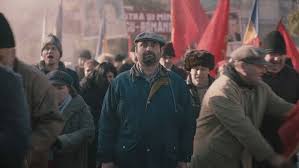
The New Year That Never Came – Winner of the Golden Pyramid at the 45th Cairo IFF
As I write these words, it’s December in my native Poland. The sky is gray, the clouds dense, shielding us from light and warmth. The night falls before 4 p.m., yet this country is full of joy and hope—unlike Romania 25 years ago, gripped by Nicolae Ceaușescu’s iron fist.
It was December 1989 when the events of The New Year That Never Came unfold. Written and directed by Bogdan Muresanu, the winner of the Golden Pyramid at the 45th Cairo Film Festival, this film is a brilliant blend of darkness and humor. In a world where oppression leaves little room for joy, humor becomes a weapon—a survival mechanism against the horrors of daily life.
The film begins on one of those gray-blue afternoons, its color palette evoking the paralyzing frailty that the regime imposed on its citizens. By the end of that month, their Gehenna will be over. Ceaușescu will be dethroned and executed by his own people. This knowledge of historical events places both the director and the audience in a semi-god position; we know what will happen next. From this vantage point, the characters’ struggles to maintain normalcy, resist the regime, or rebel secretly carry a different moral weight.
An Intimate and Absurd Portrait of Life under Oppression
Muresanu draws inspiration from fragments of his childhood memories—he was 15 at the time—but his storytelling echoes elements of Greek tragedy and comedy. Regardless of the characters’ efforts, their outcomes differ from their intentions, as if fate itself stands behind them, pulling the strings.
In this intricate tapestry, Muresanu introduces six everyday people: a worker, a secret police officer, his mother, an actress, a teenager, and a TV producer. Through their lives, he also depicts the harsh realities of life in Romania. His writing is concise and precise; each storyline complements the others, maintaining the same emotional cadence and tempo.
Cinematography and Visual Style
The New Year That Never Came blends fiction with a documentary-style vibe, primarily through its camera work, which follows the characters like an unscripted TV production. The use of the 4:3 aspect ratio, a standard format for communist-era television, adds a retro value to the visual narrative. This choice anchors the characters as both historical figures and relatable, contemporary ones. Their daily struggles are captured with an almost voyeuristic intimacy.
The film’s editing is smooth, balancing screen time for each character. This structure allows the audience to connect with each individual on a personal level, inviting them to pick their favorites, strengthening their emotional bond with the story.
The Comedy and Tragedy of Daily Life
The characters’ struggles are relatable because they reflect the absurdities of daily life under a repressive regime. Whether it’s re-shooting a Christmas special TV segment or sending an unfortunate letter to Santa (which connects to Muresanu’s earlier short film Christmas Gift), the film highlights the lengths people go to simply survive. The humorous elements often emerge from these mundane, yet bizarre moments. For instance, the TV studio reshoots offer comedic relief, even as they expose the madness of daily life.
In a telling scene, an actress struggles to buy sedatives at the drugstore—an illustration of how, under the regime, people would turn on each other to get their way. Muresanu’s sharp lens offers an ironic yet warm portrait of life under communism, reminiscent of the work of filmmakers like Christi Puiu and Cristian Mungiu.
A Philosophical Reflection on Freedom
The film goes beyond political critique, offering a deeper philosophical reflection on the human condition under oppression. While it offers a pointed look at communism, it leaves the audience to question whether true freedom exists in a post-communist world. As the film concludes, we are left to wonder: are we truly free today, or do we remain enslaved in other ways, perhaps by capitalism? Is true, unlimited freedom just a utopian dream?
Muresanu could have easily judged his characters for their actions. Instead, he adopts a half-empathetic, half-sarcastic tone, as though saying, “Why are you fretting? It will all be over soon.” This perspective offers a film that is not only darkly humorous but also poignant. It evokes both laughter and genuine fear, reminding us how fragile human lives are under authoritarian rule.
Conclusion: A Glorification of the Human Spirit
The New Year That Never Came is ultimately a tribute to the resilience of the human spirit under oppression. Through its unlikely heroes, it highlights the absurdities and obstacles of life in a totalitarian regime. Muresanu’s work offers a philosophical commentary on human nature, providing both a historical perspective and a timeless reflection on freedom and survival.